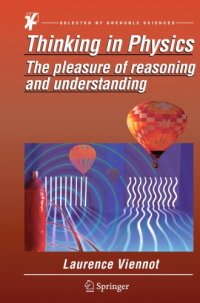
Ebook: Thinking in physics: the pleasure of reasoning and understanding
Author: Viennot Laurence
- Tags: Droit, education, Education (General), fysica, lerarenopleiding, mathematical physics, mathematische natuurkunde, natuurwetenschappelijk onderwijs, onderwijs, Onderwijs (algemeen), onderwijzen, physics, Physics--Study and teaching, science education, SCIENCE--Energy, SCIENCE--Mechanics--General, SCIENCE--Physics--General, Sciences humaines, Sciences sociales, teacher training, teaching, Electronic books, Physics -- Study and teaching, SCIENCE -- Energy, SCIENCE -- Mechanics -- General, SCIENCE -- Physics -- General
- Year: 2014
- Publisher: Springer
- City: Dordrecht;New York
- Language: English
- pdf
Read this book if you want to know how to give students the intellectual pleasure of understanding physics. Read it even if you fear that this goal is out of reach - you may be surprised! Laurence Viennot shows ways to deal with the awkward fact that common sense thinking is often not the same as scientific thinking. She exposes frequent and widespread errors and misunderstandings, which provide a real eye-opener for the teacher. More than that, she shows ways to avoid and overcome them. The book argues against over-emphasis on 'fun' applications, demonstrating that students also enjoy and value clear thinking. The book has three parts: -Making sense of special scientific ways of reasoning (words, images, functions) -Making connections between very different topics, each illuminating the other -Simplifying, looking for consistency, and avoiding incoherent over-simplification It offers a magnificent supply of insight and ideas, all of which can be put to use no matter what physics programme you teach. The examples provided in this book shed light on the processes of teaching and popularization of physics, from the high school to the early undergraduate level. "I recommend this book to all my colleagues engaged in teaching physics and other scientific disciplines, but also to students, future teachers and all those who take pleasure in understanding" Guy Aubert Emeritus Professor, Université Joseph Fourier, grenoble, France.;Foreword -- Foreword to the French Edition -- Preface -- Part I Learning to think: words, images and functions -- 1 Essential tools for comprehension -- 2 Some surprising invariances -- 3 Analysis of functional dependence: a powerful tool -- 4 Putting things into practice -- Part II Physics: linking factors -- 5 Links between phenomena in terms of type of functional dependence -- 6 The relationship between different approaches to the same phenomenon -- Part III Simplicity: ruin or triumph of coherence? -- 7 Optimising simple experiments -- 8 Popularising physics: what place for reasoning? -- 9 Conclusion -- Appendix A -- What this book owes to physics education research -- Appendix B -- The weight of air and molecular impacts: how do they relate? -- Appendix C -Causal linear reasoning -- Appendix D -- When physics should conform to beliefs: pierced bottles -- Appendix E -- Reactions of trainee journalists and scientific writers confronted with inconsistency -- Appendix F -- 'Facilitating elements" of communication: Year 11 students ranking the risks of misunderstanding.
Download the book Thinking in physics: the pleasure of reasoning and understanding for free or read online
Continue reading on any device:

Last viewed books
Related books
{related-news}
Comments (0)